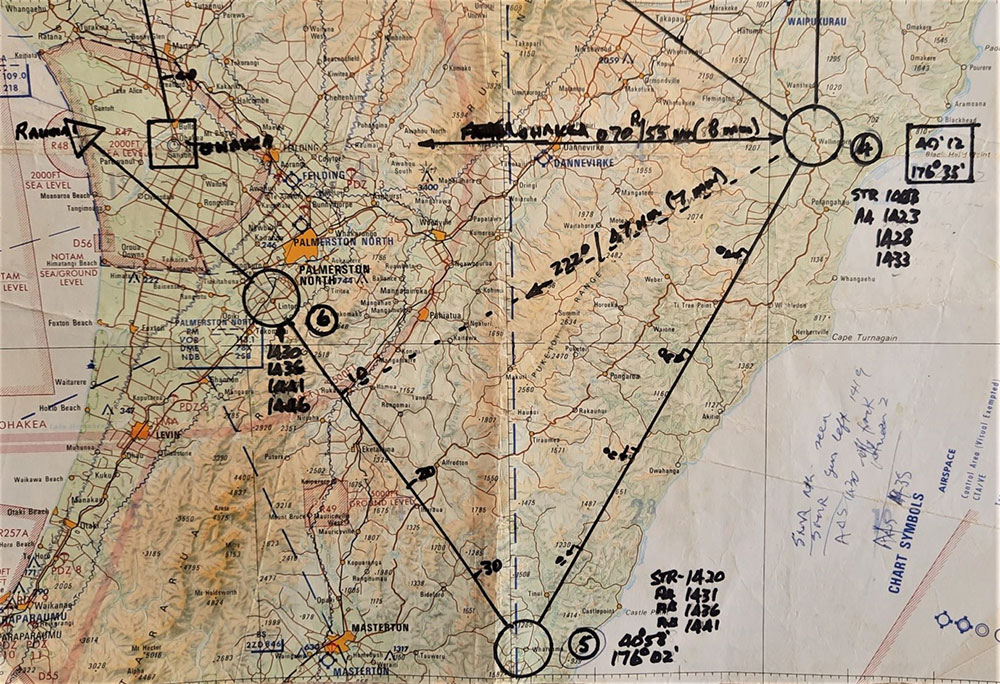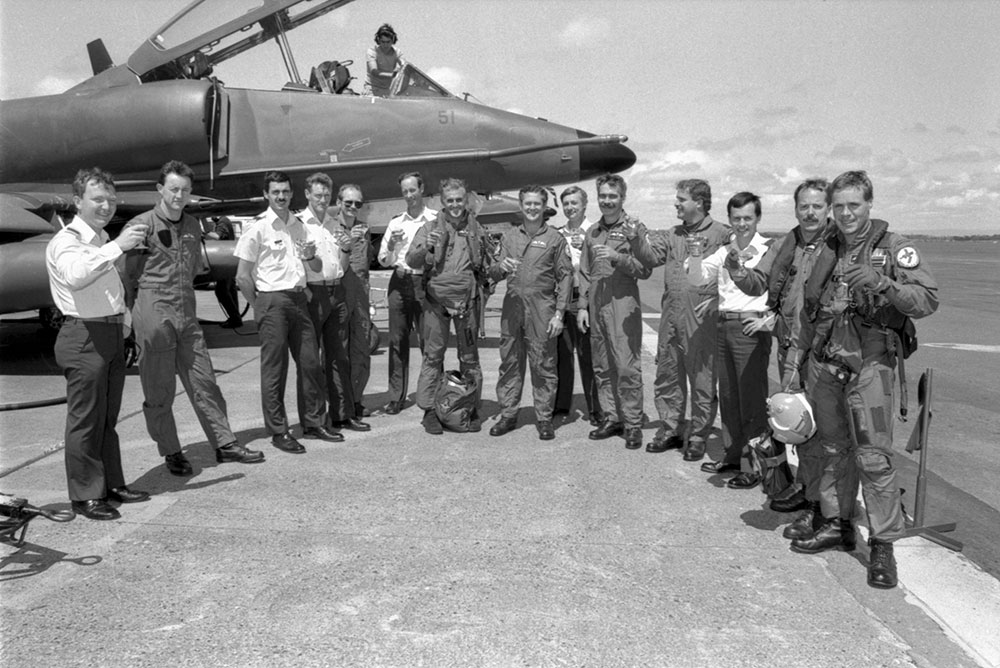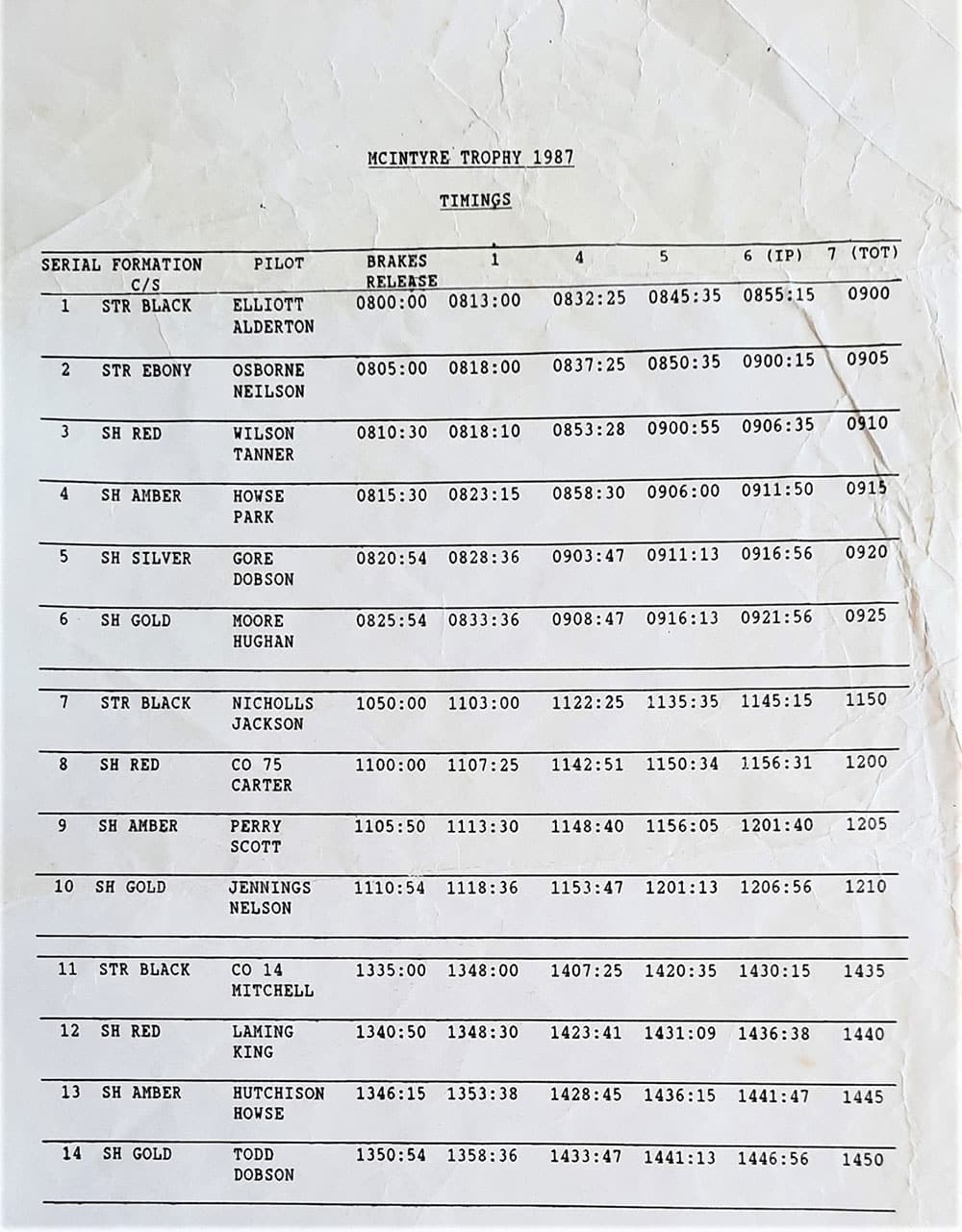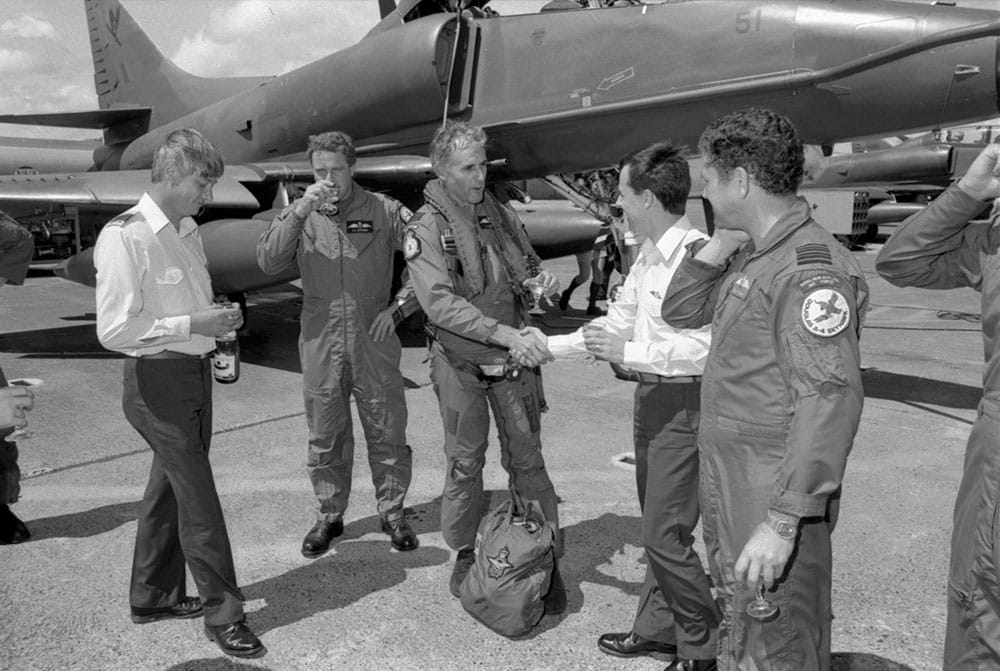My Final A4 Skyhawk Flight
My final RNZAF flight as an aircraft captain was on 11th December 1987 from RNZAF Base Ohakea, wherein I flew a two-seater Skyhawk TA4K NZ6251, with passenger LAC Glen Edwards in the back seat. The purpose of my flight was to be a ‘Red Air bandit’ to locate and ‘bounce’ successive pairs of aircraft flying a predetermined route at low level from Ohakea to Raumai Air Weapons range, which itself was located on the coastline near Ohakea. On reaching Raumai range, each aircraft was required to drop a single practice bomb as close as possible to the predesignated target and as near as possible to a pre-allocated Time on Target (TOT) for each pair of aircraft.
While each attacking pair were navigating the pre-determined low level route and keeping to the required elapsed time at each enroute turning point (TP), the purpose of my flight was to encourage each pair of attackers to maintain a good lookout so as to spot me as a ‘Red Air’ aggressor before I intercepted them – and if I was seen by any pair to be making an intercept, then a defensive turn by that pair was a signal for me to discontinue my simulated gunnery attack. If I was not detected, such that a successful simulated gunnery attack was made by me, then the attacked aircraft was considered to be ‘shot down’ and thus out of the competition.
Whilst each individual pilot recorded a bombing accuracy score and a TOT score at Raumai so as to determine an overall winner, the competition adjudicators were required to compile an average accuracy and timing score for each of Numbers 2 (A4K Skyhawk), 14 (Strikemaster), and 75 (A4K Skyhawk) Squadrons in order to determine the winning squadron for the highly coveted McIntyre Trophy; the trophy had been presented some years earlier for inter-squadron competition by a former Ohakea Base Commander, Group Captain Stuart McIntyre.
In 2022, after some 37 years since my last flight, I found in my bag of relics the original map I used on that day (see below on page 3), together with a spreadsheet (see below on page 2) showing the three blocks of ‘attackers’ throughout the day – the first block of six pairs of aircraft (one of which were Strikemasters (SMRs)) were airborne at 5 minute intervals from 0800 hours; the second block of four pairs (one of SMRs) from 1050 hours; and the third block of four pairs (again, one of SMRs) from 1335.
The SMRs flew a shorter pre-planned low level route (i.e. from Turning Point (TP) 1 directly to TP4 – see map on page 3 below) while flying at 240 Knots (which is 4 nautical miles (nm) per minute), and the Skyhawks a much longer route (see page 3 below) at 360K (6 nm/min). My mission was to locate and attack the final block of 4 pairs that were airborne from 1335hrs, and to do this I planned to be positioned mid-way between TPs 4 and 5 (see map on pages 3 & 4 below) by the time the first SMR pair were scheduled to arrive at TP4 at 1407 hours.
With the spreadsheet information in hand, and the route map and timings drawn on my map, my job was to find and attack each successive pair. I can see I wrote on my map that I ‘gunned SMR on left at 1419’, which would have been when that pair (Gordon Alexander and Craig Mitchell) were within 1 minute of TP5. I also recorded that saw ‘A4s 1430 off track’ between TP4 and TP5 (this would have been the first pair of Skyhawks flown by Don Laming and Peter King), and more ‘A4s 1435’ (this would have been the second pair comprising Chris Hutchinson and Gavin Howse). I don’t recall if I made a successful gunnery attack on any of the A4s I saw.

However, I do recall being told I passed uncomfortably close in front of an unseen Skyhawk. From my ‘perch’ position of about 2500 feet above ground level (AGL) and flying at about 420K, I saw one of what I assumed to be a pair of Skyhawks flying at about 500 feet AGL towards TP5. I applied full power in my Skyhawk, descended, and accelerated to try to catch and gun down that aircraft (flown by Chris Hutchinson). In my attack I never did see the second dark green camouflaged Skyhawk aircraft of that pair (flown by Gavin Howse), but apparently I passed close to the front of Gavin’s aircraft such that he flew through the jet-wash left by my jet as I flew unseen descending from his high left to right. Later Gavin and I talked, no doubt saying that had I have been marginally closer, a mid-air collision might have resulted and this story would not have been told on what would most certainly been have been my last flight!
On landing back at Ohakea on my final flight, a reception committee of fellow pilots greeted me on the flightline to offer their congratulations and best wishes, along with a celebratory glass of bubbles.
Having flown a total of 1331 hours over three tours in RNZAF Skyhawks (1970-1973 as a line pilot on 75 Sqn, 1983-1985 as CO 75 Squadron, and 1985-1987 as OC Strike Wing) my next assignments, until I retired from the RNZAF in late 2001, were in ‘desk jobs’ flying ‘Mahogany Bombers’.

By Jim Barclay in 2022





Richard Ketchum
Posted at 05:15h, 09 NovemberIt was cool reading your story. What was your favorite aircraft to fly ?
Jim Barclay
Posted at 16:13h, 03 DecemberVampire was a great learning platform for a novice, but very dated. When I first flew the RNZAF Skyhawks, they were new and very capable. The F4 Phantom was a great one to fly with all its multi-role capability. I think to answer your question, I’d have to say the Skyhawk was my favorite, not just because it was a very versatile aircraft but also because I was CO 75 Squadron while flying the Skyhawk on my second tour, and that brought a special buzz to lead the squadron while flying a capable jet.